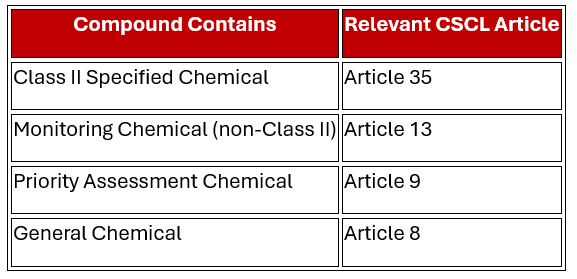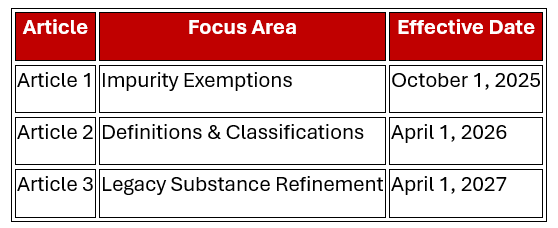Japan’s Ministry of Health, Labour and Welfare (MHLW), Ministry of Economy, Trade and Industry (METI), and Ministry of the Environment (MOE) jointly issued significant revisions to the CSCL Enforcement Regulations (Chemical Substances Control Law).
These changes aim to modernize chemical classification, improve regulatory clarity, and reduce compliance burdens for manufacturers.
The implementation is phased across three years:
• Article 1: Effective October 1, 2025
• Article 2: Effective April 1, 2026
• Article 3: Effective April 1, 2027
Article 1: Impurity Exemptions Expanded
What’s New?
Under previous CSCL rules, Class I Specified Chemical Substances were exempt from regulation if found in trace by-product levels and posed no health or environmental risk.
The updated regulation now explicitly includes impurities under this exemption—offering greater flexibility to manufacturers.
Updated Impurity Thresholds:

|
This change is expected to reduce regulatory burdens and streamline production compliance for companies managing low-level impurities.
Article 2: Definitions and Classifications Clarified
Expanded Scope of “Existing Chemicals”
The definition of Existing Chemical Substances now includes:
• Substances confirmed under Articles 3 and 5
• Substances with judgment notifications under Articles 4 and 5
• Imported substances under Article 7
Key Classification Updates:
• Hydrates and Anhydrates are treated as identical substances.
• Organic polymers receive clearer classification rules.
• Complex compounds like double salts, block/graft polymers, and ion-based compounds are now treated as single classification units.
Notification Requirements by Chemical Type:

|
These changes help align regulatory processes with actual chemical structures and compositions.
Article 3: Refinement of Legacy Definitions
The final phase, effective April 1, 2027, focuses on clarifying that “Existing Chemical Substances” are those defined under Article 2, Paragraphs 4, 5, or 7 of the CSCL. This ensures a clear legal basis for legacy substances and their regulatory treatment under the new framework.
Implementation Timeline

|
Industry Impact and Recommendations Benefits:
• Reduced compliance burden for trace-level impurities
• More consistent and logical classification of complex substances
• Better alignment with international chemical regulatory standards
Challenges:
• Requires companies to audit chemical inventories
• Updates needed to documentation and notification systems
• Regulatory teams must understand new thresholds and definitions
Action Items for Companies:
• Review product formulations and impurity levels
• Update internal CSCL compliance systems
• Consult regulatory experts or CIRS Group for guidance
• Stay informed about the phased implementation timeline
References:
i. Japan CSCL Enforcement Regulations – CIRS Group
ii. METI – Laws and Regulations on Chemical Substances
Reach out to our regulation experts on chemical and product regulatory compliances

